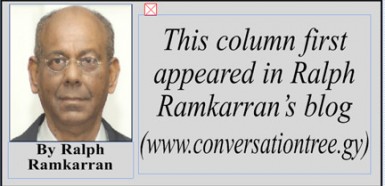The report of the Steering Committee on Constitutional Reform (SCCR), appointed by the government and headed by attorney-at-law Nigel Hughes, was handed over to Prime Minister Moses Nagamootoo in April. It is now before cabinet for a decision as to the way forward.
 President Granger, responding to a question on the television programme, Public Interest said, as reported in SN on June 20: “I don’t want a boardroom constitutional reform. I want a public discussion. I want people in their communities to meet and express their views. I don’t want a group of people sitting in a room saying what must be done.” The President went on at length in this vein.
President Granger, responding to a question on the television programme, Public Interest said, as reported in SN on June 20: “I don’t want a boardroom constitutional reform. I want a public discussion. I want people in their communities to meet and express their views. I don’t want a group of people sitting in a room saying what must be done.” The President went on at length in this vein.
In a report on a statement published in yesterday’s SN, the Guyana Human Rights Association (GHRA) welcomed President Granger’s statement and, the SN report continued: “According to the body, the committee established by the government for constitutional reform falls short of being fit for the purpose as it is monopolized by lawyers, is operating with an agenda lacking ambition and is bereft of broad-based legitimacy.”
The report of the SCCR has not been released but an article in SN of May 3 sets its recommendations in extensive detail. The origin of the fears expressed by President Granger is not known. Assuming SN’s report accurately reflects the recommendations of the SCCR, it does not preclude “people in their communities to meet and express their views,” as suggested by the President.
According to SN the SCCR recommended “a three-tiered reform system…where a group of legal experts on the Constitution Reform Commission (CRC) will prepare a draft document encompassing some of the SCCR’s recommendations. This will then be distributed to stakeholders including representatives of political parties and civil society. The CRC will then be expanded to include representatives of political parties and civil society.
The expanded CRC will then deliberate on submissions received and prepare a report which is to be perfected by its legal experts. This report will then be taken to the National Assembly for debate after which a referendum or some other method would be employed for the prospective adopting of the recommendations.”
It might not have been expressly spelt out, but deliberations on “submissions received” suggest that the recommendation by the SCCR anticipates that such submissions will be sought. It is therefore premature to assume that wide consultations would not take place. The SCCR’s recommendation is for a technical Constitution Reform Committee (CRC) to prepare a draft and then for an expanded CRC to consider submissions before finalizing the draft to be submitted.
This makes eminent sense. In 1999 the then Constitution Reform Commission (1999 CRC) considered 4,601 proposals received by way of oral and written evidence given by persons and organisations in Georgetown and from every region in Guyana, including from centrally located towns, villages and communities in the hinterland and on the coast. This was one of, if not the most extensive, uncontrived, consultation processes undertaken in relation to any issue in Guyana.
In these consultations it was a major difficulty not having a document consisting of reference points to which reference could be made. Much of the time local problems, which had no relationship to the constitution, dominated the discourse. Members of the 1999 CRC who went out on these outreaches had no answer to the local problems raised and persons would be frustrated and dismiss the exercise as a ‘waste of time.’
But first the cabinet must consider the report of the SCCR and amend it by stipulating countrywide consultations and giving a view on the preparation of a draft document. It must then get the opposition on board after considering their proposals. The details would then be matters for the CRC to decide. APNU, which will be represented on the CRC, will have an opportunity to express its opinion as to how the process should go forward.
The GHRA’s concern seems also to be premature. It is not clear whether it was referring to the composition of the SCCR, which was only a steering committee, or the initial and expanded CRC being proposed. GHRA, the government and stakeholders may wish to consider the structure of the 1999 CRC enshrined in the Constitution Reform Commission Act No. 1 of 1999 which provided for twenty members nominated by the Peoples’ Progressive Party/Civic, the Peoples’ National Congress, the United Force, the Alliance for Guyana and representatives from farmers, the private sector, indigenous peoples, women’s organisations, youth organisations, the Guyana Bar Association, Hindu religious organisations, Muslim religious organisations, Christian religious organisations and the labour movement.
Despite the charged political atmosphere at the time, agreement was arrived at by all parties as to the organisations which would nominate the persons where there was more than one representing the groups, and the process by which this would happen. Although the recommendations did not go as far as many would have liked, resulting in a continuing state of political instability driven by ethnic cleavages, the 1999 CRC successfully concluded its work after countrywide consultations, evidence from fourteen Guyanese and foreign experts and several other specialist teams. There is therefore an existing template of legal form and methodologies which no doubt informed the SCCR in its work and can assist other decision-makers and stakeholders.





